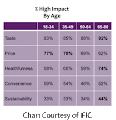Luddite - Lud-dite (noun) - an opponent of technological or industrial change.
Just about very leap forward in food science and food safety during the last century has been opposed for some reason or the other, mostly from fear of the unknown, some from not so enlightened self-interest and others from ignorance, so it comes as no surprise that genetically modified (GM) foods are under attack.
Let's look at some examples of other "new" food technologies, because early opposition to these technologies raised the same issues we are debating today and they share a common conclusion, they were wrong.
SWIFT and ARMOUR

When the Civil War broke out America was mainly an agrarian society. The Union army quickly turned to the food industry for help in feeding the troops. The results were mixed. As the saying goes, "Swift and Armour (the two giant Chicago meat packing companies) killed more Union soldiers than all the Confederates." The Union forces died from rotten meat packed in cans sealed with lead. If the bacteria filled meat did not kill the soldiers, many died a slow and painful death from lead poisoning.
The unsanitary conditions persisted into the 1900s until publication of
The Jungle which prompted an outraged President Theodore Roosevelt to move with sweeping reform legislation.
PASTEURIZATION
In the 1880s something as simple as pasteurization was vehemently opposed. Pasteur did not discover microorganisms. He made the immensely important observation that they were not a consequence of disease, decay, and putrefaction—as was the common scientific opinion at the time—but were, in fact,
he causes of these problems, and that eliminating them could eliminate the problem. This knowledge led to revolutionary changes in medicine and food preservation, not the least of which was the understanding that relatively mild heating kills microorganisms and substantially improves the safety and quality of foods without destroying desirable nutritional and sensory characteristics.
As a good Frenchman, he applied his discovery to the preservation of that most important beverage: wine. In order to “prove” the effectiveness of his process, Pasteur shipped a cargo of pasteurized wine around the world in 1868 on the French frigate, La Sybile, “without spoilage of a single bottle.”
Nevertheless, It took almost 30 more years for pasteurization to become the norm in food processing.
Frozen Foods
Ever since man began to throw meat into the snow from the cave in order to preserve it, we have been using frozen foods. However, beginning in 1929, Clarence Birdseye, a well-known taxidermist, offered his quick-frozen foods to the public. Birdseye got the idea during fur-trapping expeditions to Labrador in 1912 and 1916, where he saw the natives use freezing to preserve foods. Modern attempts at refrigeration began in the early 20th century in the meat packing industry. The first quick-frozen vegetables, fruits, sea foods, and meat were sold to the public for the first time in 1930 in Springfield, Massachusetts, under the trade name Birds Eye Frosted Foods®. Other experiments, involving orange juice, ice cream and vegetables were conducted by the military near the end of World War II.
Eighty-three years after Birdseye first introduced product into the consumer marketplace, critics still complain about the quality, composition and nutrition of frozen foods but the public has spoken and industry has responded with ever changing products produced from from Fortune 50 food companies to the all organic crowd.
GMOS: AMA and AND

Fear is the powerful motivator and the verbal and minds- eye image of "Frankenfood," certainly gives one reason to pause and hope that all the right people are asking all the right questions about the introduction of this technology into the marketplace in forms that go beyond major crops such as corn and soybeans.
Labeling is a hot-button issue. Currently, there's no federal requirement to label, because FDA has declared the GM foods identical, in nutrition and safety, to their non-GMO cousins. FDA argues reasonably there is no need to label a safe product.
Opponents point out that consumers increasingly feel they have a right to know what is in the food they eat-particularly when it comes to GMO. In a 2012 survey by the consumer research company The Mellman Group, 91 percent favored labeling.
The industry has polled consumers intensively on labeling issues since the Nutrition Facts Box first appeared. This vast body of research tells us that consumers, when asked, want every imaginable type of information on front panel packaging, from country of origin to multiple breakdowns of fat. Whether consumers understand what they are asking for is another question. Most consumers cannot tell the difference of a poly unsaturated fat to an omega 3 product, much less the complexities of grams and percent of daily values of the current Nutrition Facts Box. Most consumers cannot tell you a potato is a vegetable, much less one that is loaded with potassium and dietary fiber, two "nutrients of concern," according to top federal health policy makers. Just ask your nearest Registered Dietitian.
Today, About 80 percent of the major crops come from GM seeds, so a warning on just about every food that contains this genetic material equals a warning about nothing, especially when one cannot distinguish the GM product from the natural product.
The risk avoidance FDA has taken forever, as it usually does, to review GM foods in the scientific pipeline such as a GM salmon. We are going to have to wait longer for a decision. It's an election year and the Obama Administration does not want a GM decision clouding its presidential messaging. There are no votes for the Obama Administration if it approves a GM fish this year.
On the merits of the science, in mid July, the American Medical Association announced in a statement that they saw no health purpose for labeling genetically modified foods -- those made with GMOs (or genetically modified organisms) -- as such.

AMA underscored, "There is no scientific justification for special labeling of bioengineered foods, as a class, and that voluntary labeling is without value unless it is accompanied by focused consumer education. . .We also urge the FDA to remain alert to new data on the health consequences of bioengineered foods," AMA board member Dr. Patrice Harris.
However, the AMA, inserted a "poison pill" into its statement. The organization went on to recommend mandatory pre-market safety testing with the FDA for any modified food. No other issue, except the freedom to advertise its products to the public, is nearer to the heart of the food industry. In the past, it has "gone to the mattresses" to avoid pre-market approval of foods. Currently, companies "consult" with the FDA since no one wants the Agency to issue a warning letter about their product after they have spent tens of millions to produce and launch it.
In 2006 the American Dietetic Association, now the Academy of Nutrition and Dietetics, issued a policy statement that agricultural and food biotechnology techniques can enhance the quality, safety, nutritional value, and variety of food available for human consumption and increase the efficiency of food production, food processing, food distribution, and environmental and waste management. The American Dietetic Association "encourages the government, food manufacturers, food commodity groups, and qualified food and nutrition professionals to work together to inform consumers about this new technology and encourage the availability of these products in the marketplace." Great.
Nearly a decade ago, in 2004 an investigation from the National Academy of Sciences into the relative regulation and safety testing of genetically modified and conventional foods found that either method can result in problems like food allergens and pathogens. “All foods, whether or not they are genetically engineered, carry potentially hazardous substances or pathogenic microbes and must be properly and prudently assessed to ensure a reasonable degree of safety," read the report.
What's Next?
So what do we do? Do we wait, like Pasteur, for thirty years to pass before accepting GM foods into our homes?
California, which likes to set its own food and environmental policies and then force the FDA and the food industry to meet its standards since it has the largest consumer market in the country, may go its own way. There is a Proposition on the November ballot that would require labeling of GM foods.
Obviously the industry is spending a fortune to defeat the measure, but as in so many food controversies since 1986, as California goes, so goes the nation.








